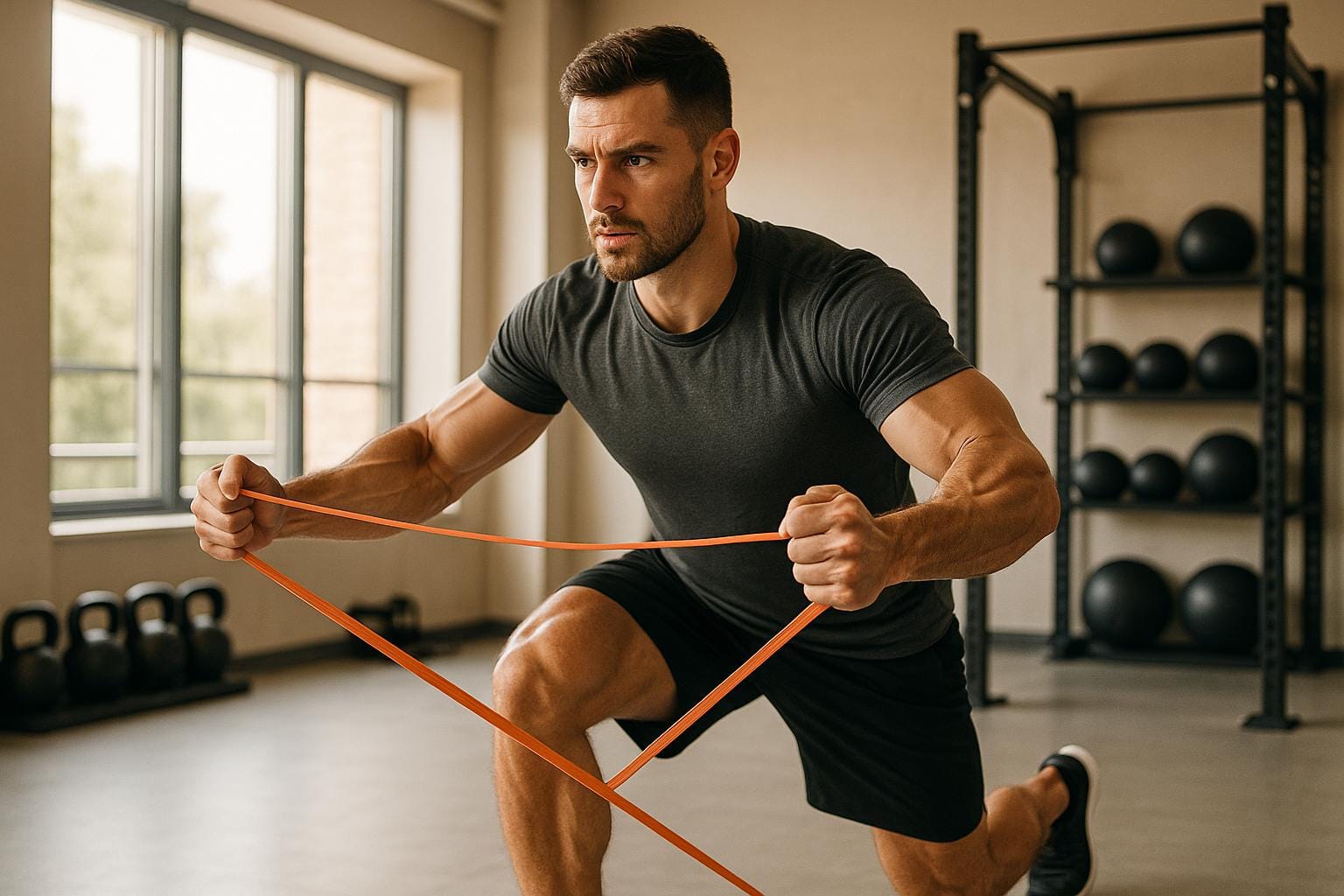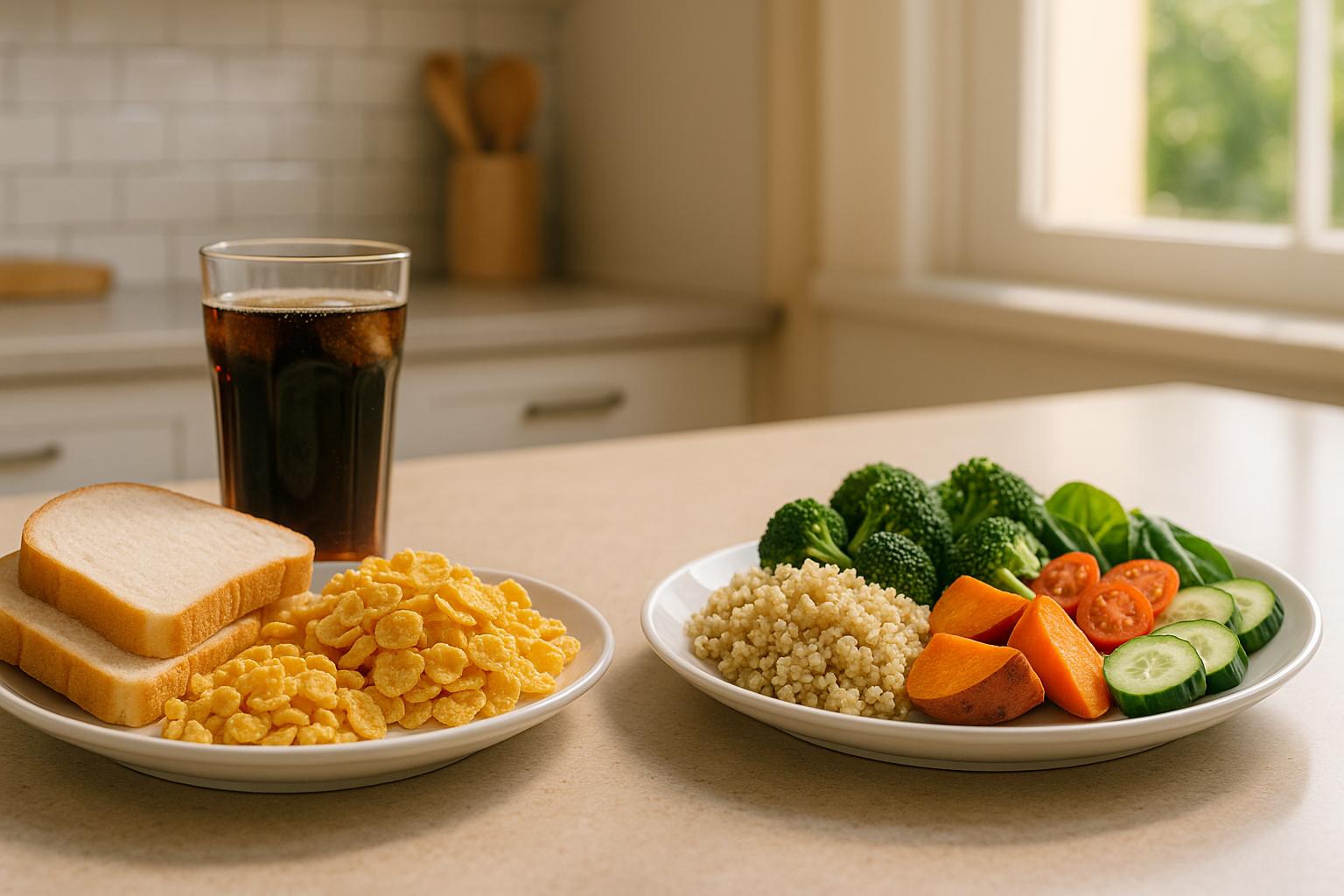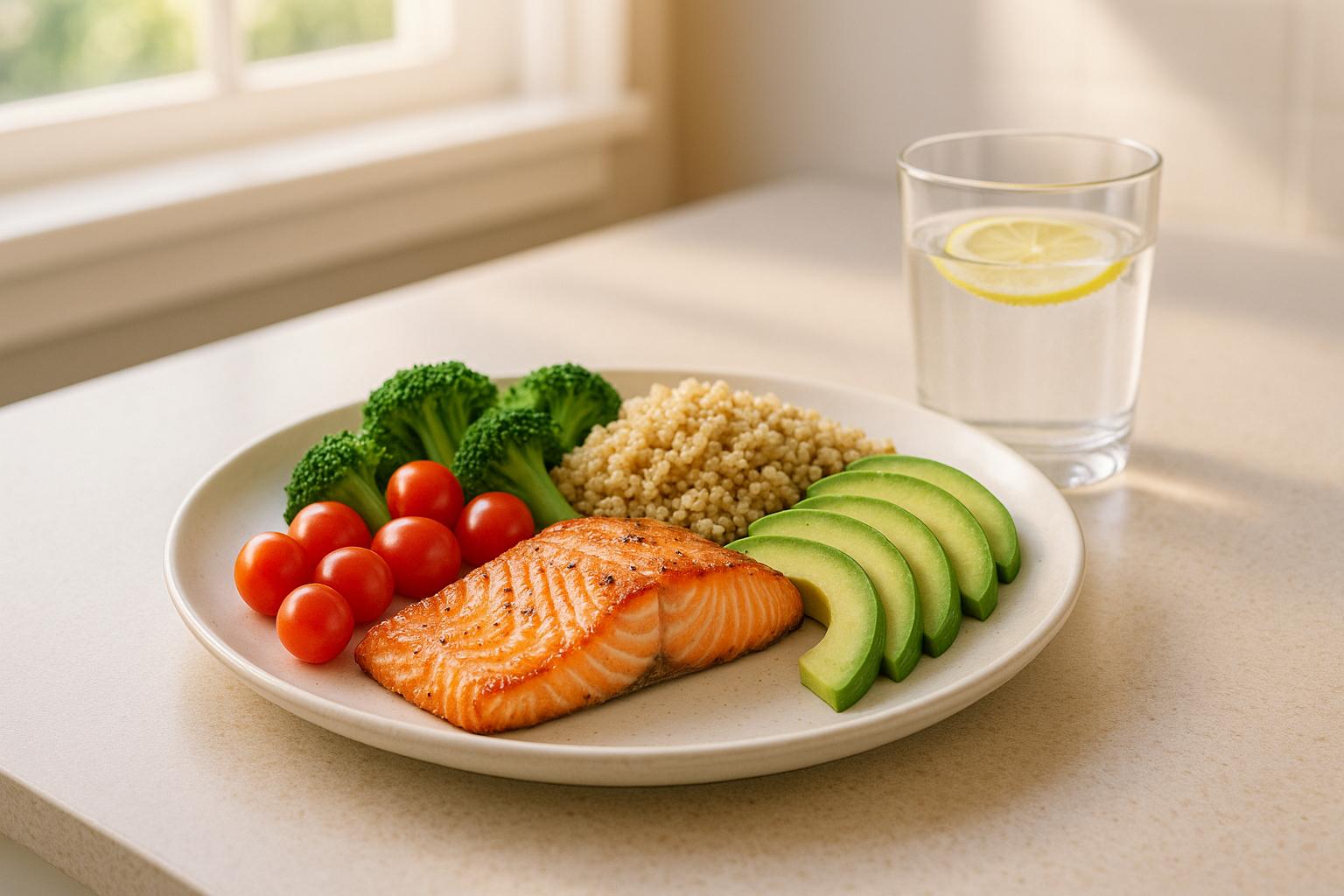Variable resistance training (VRT) adjusts resistance to match your natural strength curve, making exercises safer and more effective. Here's why it's gaining popularity:
- Build Strength and Power: Aligns resistance with your muscles' capabilities, leading to faster and greater strength gains.
- Maximize Muscle Activation: Engages more muscle fibers throughout the movement for consistent tension.
- Protects Joints: Reduces stress on joints by adapting resistance to your body's biomechanics.
- Avoid Plateaus: Keeps workouts challenging and fresh with dynamic resistance adjustments.
- Boosts Muscle Growth: Increases time under tension, especially during the eccentric phase, promoting hypertrophy.
- Improves Sports Performance: Tailors resistance to mimic sport-specific movements, enhancing power and efficiency.
- Accessible for Everyone: Works for beginners, athletes, and those in rehabilitation with customizable resistance options.
Quick Comparison Table
| Feature | Variable Resistance Training (VRT) | Constant Resistance Training (CRT) |
|---|---|---|
| Strength Gains | Higher across all levels | Moderate |
| Muscle Activation | Matches strength curve | Limited by weakest point |
| Joint Safety | Reduces stress | Constant load |
| Training Efficiency | Dynamic and engaging | Static and repetitive |
| Beginner-Friendly | Easier entry with lighter loads | Steeper learning curve |
| Sport-Specific Adaptability | Highly tailored | Generalized |
VRT offers a smarter, safer, and more efficient way to train. Whether you're a beginner or an athlete, it adapts to your needs while delivering better results. Ready to give it a try?
Variable vs. Constant Resistance Training: What’s the difference?
1. Better Muscle Strength and Power Development
Variable resistance training is a game-changer for building strength because it aligns resistance with your natural strength curve. According to research published in The Journal of Strength and Conditioning Research, this method leads to significantly greater strength gains compared to constant resistance training.
The data backs this up. A detailed meta-analysis revealed that variable resistance training results in much greater improvements in maximum strength. The overall effect size was measured at 0.80, with trained athletes showing an effect size of 0.57, while untrained individuals saw a dramatic effect size of 1.34.
Power development also sees a noticeable boost with variable resistance. In one study, athletes who added just one weekly session of variable resistance training over a five-week period achieved a higher rate of power development than those sticking to constant resistance alone. Tonal coach Joe Rodonis explains it well:
"Constant resistance slows movement as load increases. With variable resistance, resistance peaks where your muscles are strongest."
This approach works by matching resistance to your strength curve, which optimizes motor unit recruitment and firing rates. These neuromuscular changes shorten the deceleration phase and increase mean power during each rep. Plus, the eccentric phase gets a stronger stimulus, which helps speed up force development. These adaptations lay the groundwork for even more performance gains.
Interestingly, the strength improvements are most pronounced at loads of 80% or more of your one-rep max (1RM), with an effect size of 0.76. For beginners, the benefits are even more striking, with lighter loads producing an effect size of 2.38.
2. Better Muscle Fiber Recruitment Across Movement Phases
Variable resistance training (VRT) takes muscle engagement to the next level by recruiting fibers more effectively throughout every phase of a movement. Unlike traditional constant-load exercises - which often lead to uneven muscle activation - VRT adjusts resistance to match your muscles' natural ability to generate force at different joint angles.
In conventional strength training, muscle activation tends to fluctuate as you move through an exercise. This inconsistency often causes a "sticking zone", where muscles are at their weakest, slowing the movement. VRT addresses this issue by dynamically adjusting the resistance. Studies show that VRT keeps muscle tension high across all joint angles, ensuring your muscles stay engaged from start to finish. This continuous tension not only challenges your muscles but also primes your neuromuscular system for better overall performance.
VRT also enhances neuromuscular efficiency by increasing motor neuron excitability, which helps improve muscle contractile capacity and activates fast-twitch fibers more effectively.
As Yongfu Liu et al. explain:
"The gradually increasing load during the concentric phase of VRT can adjust to the force generation capacity of muscles at various joints, thereby optimizing strength performance."
The lighter resistance at the start of a movement allows for greater speed and better neuromuscular activation. As the resistance ramps up, more muscle fibers are called into action to meet the increasing demand. This creates a state of "appropriate instability", maintaining steady muscle tension - especially during the eccentric phase. The result? Greater total work and higher muscle activation compared to constant resistance training.
3. Joint-Friendly Training Approach
One of the standout benefits of variable resistance training (VRT) is how it helps protect your joints. By working in sync with your body's natural biomechanics, VRT reduces unnecessary joint strain, making it especially helpful for people with joint issues or those recovering from injuries.
Here’s how it works: VRT adjusts resistance based on your joint position. It decreases resistance when your joints are at their most vulnerable and increases it when they’re in stronger, more stable positions. This aligns perfectly with your body's natural strength curve - requiring less force at the bottom of a movement, moderate force in the middle, and maximum force at the top.
This tailored approach has been shown to be particularly effective for those dealing with joint problems. For example, research on individuals with anterior cruciate ligament (ACL) injuries revealed that adding elastic resistance during squats didn’t increase strain on the injured ligament. Similarly, studies found that performing knee-extension exercises with variable resistance resulted in significantly less stress on the patellofemoral joint compared to using constant resistance, particularly at 90°, 75°, and 60° of knee flexion.
Another advantage of VRT lies in its smoother and more controlled movements, thanks to tools like bands and springs. Unlike free weights, which can sometimes cause abrupt, jarring forces, these tools provide resistance that gradually increases, matching your muscles' natural strength patterns. This makes VRT a great option for older adults, people with arthritis, or anyone easing back into exercise after an injury.
Christian Bosse, a respected strength and conditioning coach, highlights the difference between resistance types:
"The resistance provided by chains is linear, whilst bands provide the resistance exponentially."
This flexibility allows you to select the resistance style that feels best for your joints and aligns with your training goals. Whether you’re using bands, chains, or cam-based machines, VRT ensures your joints are safeguarded while your muscles are thoroughly challenged. These biomechanical benefits provide a safer and more effective way to train.
4. Better Training Efficiency and Plateau Prevention
Variable resistance training (VRT) is a game-changer when it comes to avoiding the frustrating plateaus that can derail your progress for weeks - or even months. Unlike traditional weightlifting, which relies on static loads, VRT introduces constantly changing resistance. This forces your muscles to adapt in new and challenging ways, keeping your workouts fresh and effective. One standout example of this is the bench press, where VRT can lead to noticeable improvements.
Here's something interesting: during a bench press performed at 80% of your one-rep max (1-RM), about 52% of the upward movement is focused on deceleration. Compare that to just 40% at 45% 1-RM. This means traditional training often misses out on stimulating your muscles effectively during a large portion of each rep. VRT, however, minimizes the deceleration phase, maintaining constant tension throughout the entire movement. This results in higher average power per rep and more efficient muscle activation.
By aligning resistance with your natural strength curve, VRT addresses a key limitation of conventional training methods. It ensures that resistance matches your body's natural strength patterns, leading to better muscle fiber recruitment and faster strength gains. Plus, it boosts motor unit recruitment and firing rates, engaging more muscle fibers for greater overall power and efficiency.
One of the best parts? VRT is incredibly flexible. You can tweak resistance curves, swap out equipment (like bands or chains), or adjust tension patterns without completely revamping your workout routine. Whether you change weights, modify exercise duration, or try new movements, this adaptability keeps your muscles guessing and growing.
With its dynamic approach, VRT ensures your muscles are always adapting, making it easier to avoid stagnation and continue progressing. This method doesn’t just prevent plateaus - it sets you up for continuous improvement and long-term success.
5. Increased Time Under Tension for Muscle Growth
Variable resistance training (VRT) changes how tension is applied to your muscles during each rep, creating an ideal setup for muscle growth. Unlike traditional weights that apply the same resistance throughout a movement, VRT challenges your muscles more when they’re strongest and keeps tension constant across the entire range of motion. This extended time under tension (TUT) plays a key role in stimulating muscle hypertrophy, as supported by scientific research.
Here’s the science: when you use variable resistance, your muscles stay engaged for a longer period during each repetition. For example, slow-tempo leg extensions (6 seconds up and down) at 30% of your one-rep max (1RM) result in greater muscle protein synthesis compared to faster tempos (1 second up and down). This highlights how prolonged tension can amplify muscle growth.
One standout aspect of VRT is its focus on the eccentric phase - the lowering part of a movement. This phase is crucial for inducing muscle fiber damage and promoting recovery. Research shows that eccentric training can lead to around 10% muscle growth, compared to 6.8% with concentric training. VRT naturally emphasizes the eccentric phase by maintaining higher tension as your muscles lengthen, setting the stage for optimal hypertrophy.
Another advantage of VRT is its ability to align with your body’s natural strength curve. Take heavy resistance bands, for instance. As these bands stretch, they provide increasing resistance, ensuring your muscles face maximum tension right when they’re most capable of handling it. This approach not only keeps tension constant but also allows for extended sets with a diminishing range of motion, signaling to your body that it needs to build more muscle.
To make the most of VRT, you’ll want to experiment with different tempos. Repetition tempos ranging from 0.5 to 8 seconds have been shown to produce similar muscle growth. A good strategy is to pair fast concentric movements with slower eccentric phases lasting 2–6 seconds, or even double the duration of the concentric phase.
Another benefit? Using lighter base weights with VRT reduces stress on your joints while still delivering extended tension. This combination of sustained muscle engagement, improved strength, and joint-friendly techniques underscores the well-rounded benefits of variable resistance training.
This article is for informational purposes only and is not intended as medical advice. Please consult a healthcare professional before starting any new fitness or wellness routine.
6. Sport-Specific Performance Adaptation
Variable resistance training (VRT) is designed to mimic the demands of real-world sports by adjusting resistance during non-linear movements. By tailoring resistance to align with an athlete's peak force output, VRT helps prepare them for the unique challenges of their sport. This approach has been linked to measurable performance improvements.
For example, research conducted at Cornell University revealed impressive results: athletes using VRT achieved double the gains in bench press 1-rep max (1RM), tripled their squat improvements, and significantly increased average power output. Similarly, a 2017 study focused on elite youth rugby league players from the Catalans Dragons academy highlighted that, over six weeks, those incorporating VRT - using elastic bands for 20% of the load - saw greater increases in both absolute (5.2%) and relative bench press 1RM (5.9%) compared to those following traditional strength training protocols.
Combat sports have also benefited from VRT. A 2024 study on elite female boxers demonstrated notable improvements in bench press, squat performance, and single punch speed, force, and power. In professional rugby, players reported increased pushing power after just seven days of VRT, while a single session boosted jump performance - results not observed with conventional training methods.
When implementing VRT, coaches are encouraged to focus on key joint angles and movement patterns to maximize effectiveness. This is particularly valuable for contact sports like football, rugby, and wrestling. These sports demand explosive power and benefit from VRT’s ability to provide resistance that varies throughout the movement. Additionally, VRT can help reduce injury risk by minimizing force on vulnerable joint positions. By targeting sport-specific adaptations, VRT not only enhances performance but also helps refine training strategies tailored to the needs of each athlete.
This article is for informational purposes only and is not intended as medical advice. Please consult a healthcare professional before starting any new fitness or wellness routine.
7. Accessibility Across All Fitness Levels
Variable resistance training (VRT) is designed to suit everyone, from beginners just starting their fitness journey to elite athletes pushing their limits. Its adaptable nature ensures that exercises can be customized to match any fitness level or physical ability.
One of VRT's standout features is its range of resistance options. Resistance bands, for example, come in strengths that span from less than 1 pound to over 600 pounds. This variety means that someone recovering from an injury can start with minimal resistance, while a powerlifter can challenge themselves with much heavier loads.
For beginners, VRT offers a gentle entry point. Light resistance exercises can help improve flexibility and build muscle tone without overwhelming the body. Intermediate users can step up their routines by alternating between lighter and heavier bands, keeping workouts engaging and progressive. They might also swap free weights for bands or add band exercises to cardio sessions for an extra challenge. Advanced athletes, on the other hand, can push their limits further. By combining heavier resistance bands with free weights or incorporating bands into their max-effort lifts, they can target muscle groups more effectively and break through training plateaus.
VRT also shines in rehabilitation settings. It provides a safer and more controlled alternative to traditional weight training, making it ideal for those recovering from injuries. By gradually building strength and stability around injured joints, VRT ensures that exercises remain accessible even for individuals with physical limitations.
What makes VRT even more appealing is its adaptability. Trainers can tweak intensity, range of motion, speed, or body positioning to meet individual needs. This means that the same equipment can benefit a 70-year-old recovering from knee surgery and a 25-year-old professional athlete - simply by adjusting how it's used.
Research backs up VRT's effectiveness. A 2020 study by Staniszewski et al. found that both strength and hypertrophy training protocols using VRT led to improvements in biomechanical, biochemical, and anthropometric markers. Whether the goal is building muscle, increasing strength, or improving overall fitness, VRT proves to be a reliable tool.
Another reason VRT is so accessible is its convenience. Resistance bands are lightweight, portable, and budget-friendly, removing barriers like expensive gym memberships or travel time.
This article is for informational purposes only and is not intended as medical advice. Please consult a healthcare professional before starting any new fitness or wellness routine.
Comparison Table
When deciding between variable resistance training (VRT) and standard resistance training (CRT), the differences in performance outcomes are quite striking. Research highlights how these two methods impact key training metrics in distinct ways.
| Training Metric | Variable Resistance Training (VRT) | Standard Resistance Training (CRT) | Research Findings |
|---|---|---|---|
| Maximum Strength Gains | Greater improvements across all fitness levels | Solid baseline strength development | Meta-analysis shows an effect size of 0.80 for VRT compared to CRT |
| Trained Athletes Performance | 57% higher strength gains | Standard progression rates | Trained individuals saw higher gains with VRT (ES = 0.57) |
| Beginner-Friendly Results | Outstanding strength gains with lighter weights | Moderate progress | Untrained participants achieved better results with VRT (ES = 1.34) |
| Joint Stress & Safety | Eases stress on vulnerable joints while increasing resistance where stable | Constant load throughout the range of motion | A 2019 study found VRT reduced shoulder pain during bench pressing |
| Muscle Activation Pattern | Matches natural strength curve, addressing sticking points | Limited by weakest range of motion | VRT enhances motor unit recruitment and firing rates |
| Training Efficiency | Balanced load distribution throughout movement | Less effective due to unchanging resistance | VRT generates greater neural fatigue and hormonal responses |
| Load Recommendations | <80% 1RM for beginners; ≥80% 1RM for advanced users | Follows standard percentage-based progression | Effective VRT relies on tailoring loads to the user’s experience level |
These findings highlight how VRT's unique mechanics can lead to more effective and safer strength training outcomes. For example, untrained individuals using VRT with loads under 80% of their one-rep max (1RM) saw impressive improvements (ES = 2.38), while experienced lifters also made notable gains (ES = 0.76).
"Variable resistance training can be a safer and more sustainable way to make gains, because it reduces the load on your joints at their most vulnerable position."
– Joe Rodonis, Tonal coach and certified personal trainer
One of VRT's standout benefits is its ability to reduce joint stress by adjusting the load according to your body's natural strength curve. This adaptability not only enhances strength gains but also minimizes the risk of injury. In contrast, CRT applies a constant load, which can limit muscle engagement, especially at weaker points in the range of motion.
Additionally, VRT's load adjustments allow for better motor unit activation and firing rates, which contribute to faster strength improvements. For beginners, lighter loads combined with VRT's tailored resistance can lead to significant progress. For advanced athletes, heavier loads paired with VRT can push performance to new levels.
Overall, VRT offers a more personalized training experience, moving away from the rigid, one-size-fits-all approach of standard resistance training.
This article is for informational purposes only and is not intended as medical advice. Always consult a healthcare professional before starting a new fitness routine.
Conclusion
Variable resistance training (VRT) has emerged as a game-changer in the fitness world, addressing many of the challenges posed by traditional weightlifting. It delivers improved strength gains, better muscle activation, enhanced joint safety, and greater efficiency during workouts. Research backs up these claims, showing that VRT can lead to superior strength improvements compared to conventional methods. This makes it a valuable tool for athletes and fitness enthusiasts alike.
One of the standout benefits of VRT is its positive impact on joint health. Studies have shown that chain-assisted VRT can help reduce shoulder pain. By adjusting resistance throughout the movement - reducing stress during vulnerable phases and increasing it where your muscles are strongest - VRT offers a safer and more sustainable way to train.
But the benefits don’t stop there. VRT also boosts muscle fiber recruitment, improves training efficiency, and supports sport-specific performance goals. Whether you’re a beginner just starting out or a seasoned athlete looking to push past plateaus, VRT ensures progressive overload and consistent results.
"Variable resistance training is the most effective way to build muscle and burn fat."
– Dr. John Jaquish, Author of Weight Lifting Is a Waste of Time
VRT is also highly adaptable, utilizing tools like resistance bands, chains, or specialized machines. These options make it accessible to anyone, regardless of experience level. Whether your goal is to break through a fitness plateau, protect your joints, or simply make your workouts more effective, VRT provides a practical and versatile solution.
To get started, Fitup offers detailed guides packed with science-backed insights and tips for safely incorporating VRT into your routine. Remember to begin slowly, focus on proper form, and allow your body to adapt to this unique training method.
This article is for informational purposes only and is not intended as medical advice. Please consult a healthcare professional before starting any new fitness or wellness routine.
FAQs
How does variable resistance training help protect your joints compared to traditional resistance training?
Variable resistance training (VRT) takes care of your joints by adjusting the resistance as you move, easing the strain when your joints are in their most delicate positions. This adjustment creates a smoother, more natural movement pattern and helps lower the chances of overloading or injuring specific joints and muscles.
Here’s how it works: VRT reduces the load at the beginning of a lift - when your joints are less stable - and gradually increases resistance as your muscles gain better leverage and strength. This approach makes it an excellent option for those with joint sensitivities or existing issues, offering a safer and more joint-conscious alternative to traditional resistance training.
Can beginners include variable resistance training in their workouts, and what’s the best way to start?
Yes, beginners can definitely include variable resistance training (VRT) in their workout routines. This technique relies on tools like resistance bands or chains to modify resistance throughout a movement, matching your muscles’ natural strength curve. It’s an effective way to build strength while being gentle on your joints, making it an excellent option for those just starting out.
To begin, focus on straightforward exercises such as squats, rows, or bicep curls with resistance bands. Start with a lighter resistance level and gradually increase it as your strength and confidence grow. This steady progression helps you improve safely while lowering the chances of injury.
What equipment is used in variable resistance training, and how does it improve workout results?
Variable resistance training involves using tools like resistance bands, chains, and specially designed machines to make workouts more dynamic and effective. Here's how it works: resistance bands create greater tension as they stretch, which means your muscles face more challenge during the stronger parts of an exercise. Chains operate on a similar principle, gradually adding weight as you lift, aligning the resistance with your natural strength curve.
Additionally, specialized machines equipped with adjustable resistance mechanisms can adapt to your strength at different points of a movement. This method not only promotes muscle growth and strength development but also minimizes joint strain, offering a safer and more efficient way to train.












